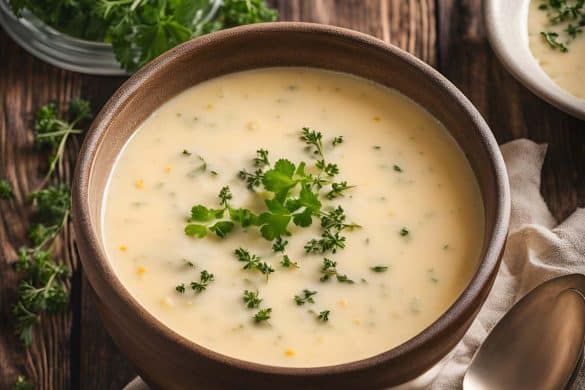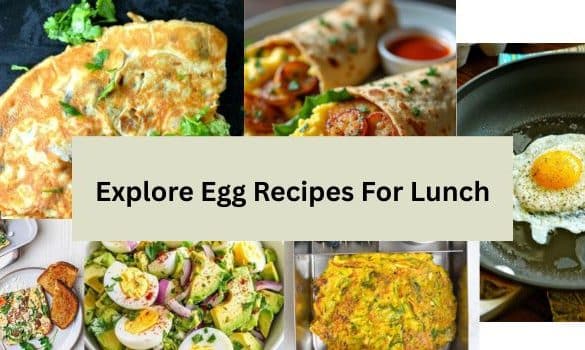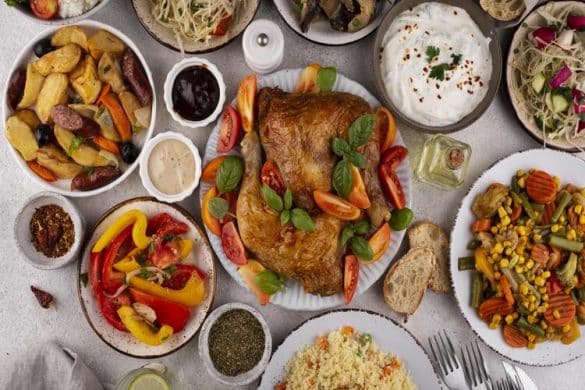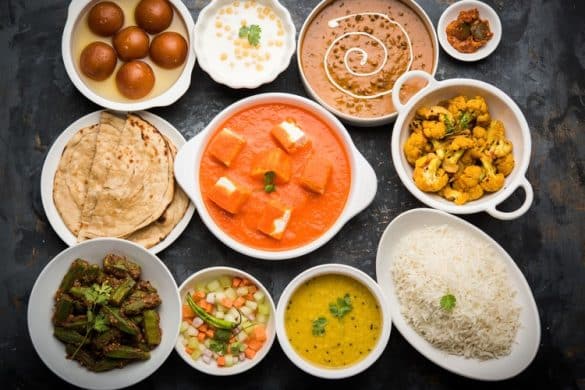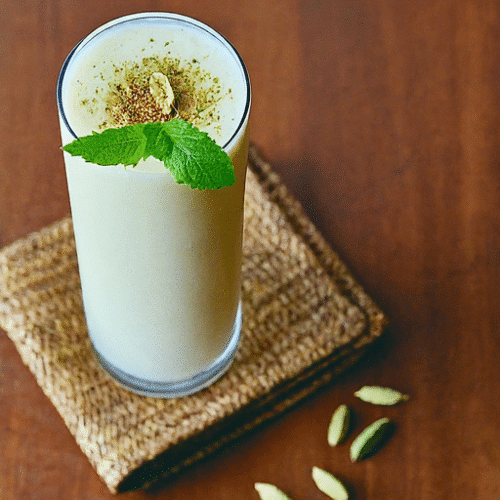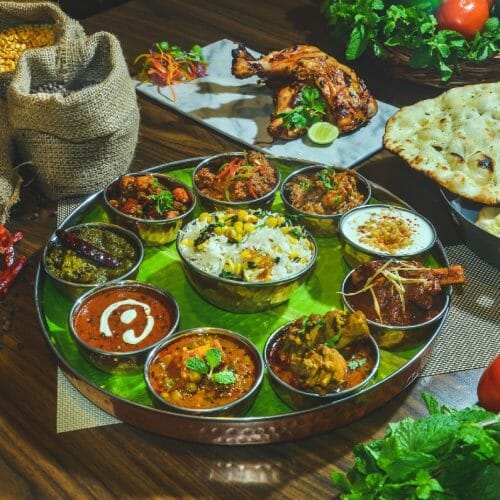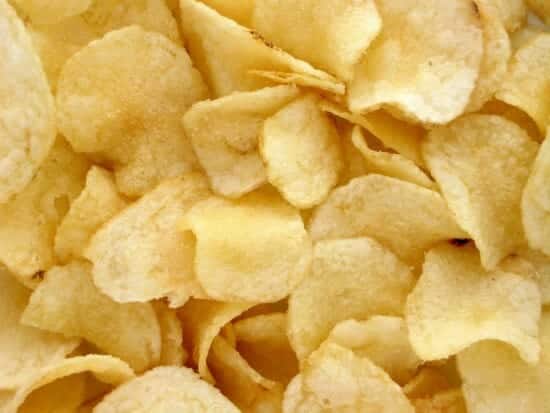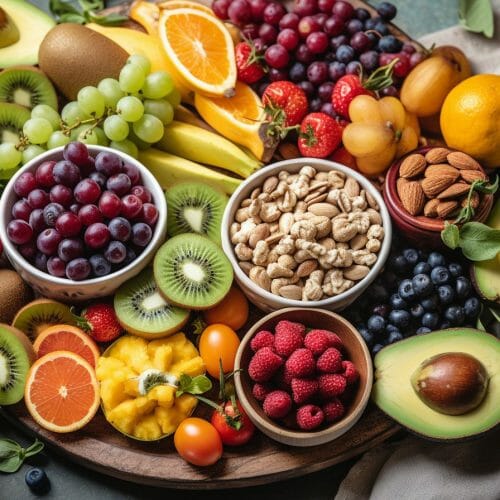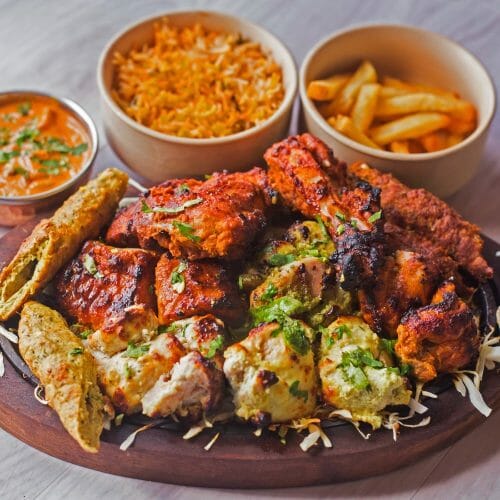Ghee, derived from cow milk butter, holds a special place in Middle Eastern and Indian cuisines. This rich, golden-hued, aromatic fat source is achieved by treating butter under low heat until water evaporates, leaving behind milk solids that are subsequently skimmed off or strained. What remains is a nutrient-rich liquid fat known as ghee.
Packed with unique properties due to low heat treatment, usually under 100 F, ghee gained recognition as a nutritious alternative to standard butter. Originating as a food preservation technique in hot climates of India, ghee has now become a culinary and health phenomenon worldwide.
This blog will share all the known and unknown applications of this exceptional superfood, combining its health benefits with versatile usage across dishes and easy home preparation.
How does ghee enhance cooking and flavouring?
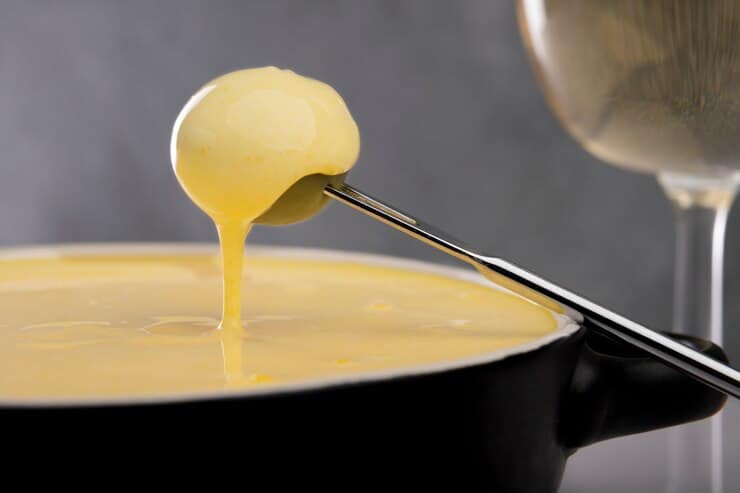
A golden pool of ghee poured with a spoon into a bowl
Ghee, with its high smoke point and rich flavour, provides ample opportunities to elevate culinary experiences. Unlike other cooking fats, ghee doesn’t burn or smoke quickly, offering a distinct advantage during high-heat cooking. It not only enhances the flavour but also contributes to a dish’s overall health profile, making every spoonful an infusion of nutrition.
You can also read: Why ghee is an important ingredient in Indian cuisine.
1. To make traditional Indian dishes
Traditionally, ghee has been intrinsic to Indian cuisine, imparting a unique depth of flavour and richness to dishes. In several traditional delicacies like biryani, naan, and gajar ka halwa, ghee becomes an essential ingredient, enhancing the aroma, taste, and texture of these dishes.
- Ghee’s high smoke point makes it an excellent choice for sauteing spices, an integral part of Indian culinary
- You can also find ghee being liberally used in sweets and desserts like laddus, halwas, pancakes, etc., where it assists in binding ingredients, enhancing flavour, and providing an indulgent mouthfeel.
- Ghee holds a prime position in various rituals and festivals in India. For instance, ghee lamps are a common sight in most Indian homes during the festival of lights, Diwali.
By considering ghee as not just a cooking ingredient but also a symbolic substance, it is intertwined with cultural, religious, and social practices across the subcontinent.
Check out this Kanchipuram ghee Idli, which is a traditional charm of Kerala.
2. For baking and roasting
Ghee’s nutty flavour and high smoking point make it a perfect candidate for baking and roasting.
- Ghee’s ability to withstand high temperatures without turning rancid makes it a safe and smooth ingredient for grilling, barbecuing, and pan-searing.
- Its rich profile does not just add a flavour nuance but also contributes towards a crispier, more delicious crust in bread loaves, pies, tarts, and cookies.
- Even though ghee is not a direct substitute for butter in baking, owing to the lack of milk solids that contribute to the texture of baked goods, it can still be used for an interesting twist in baked dishes.
- It can bring about an exciting change in taste, providing a unique richness and a touch of exotic flavour profile to standard recipes.
When applied to vegetables or fruits before roasting, it enhances caramelisation, resulting in dishes bursting with flavour.
3. For spreading and topping
From spreading it over warm bread to pouring it over cooked vegetables, rice, or stews, ghee can elevate even the simplest dishes with its rich, nutty flavour. From replacing your regular butter in grilled cheese sandwiches to drizzling over pancakes, popcorn, or risotto, ghee’s applications as a spread or topping are numerous. By using ghee as a topping, not only do you improve the taste, but you also infuse more nutrients into your dish.
A simple bowl of steamed rice or cooked quinoa. A spoonful of ghee added to this can instantly transform the dish into an aromatic, flavourful, and comforting meal. Whether you’re running short on time or wish to boost your meals nutritionally, spreading or topping your food with ghee could be a quick and delicious solution.
What are the nutritional benefits of ghee?
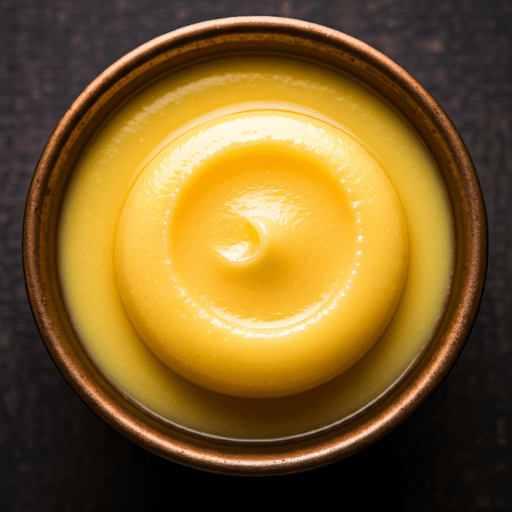
Bowl of clarified butter or ghee
Apart from making your dishes more flavourful, ghee serves as a nutritional powerhouse, loaded with essential vitamins like A, D, E, and K, antioxidants, and healthy fats. Even though it is high in fat, it possesses healthful fatty acids that may support a healthy heart, digestion and weight management. Consuming ghee can also help your body absorb more nutrients from the food you eat. Thus, ghee combines the benefits of good taste with added nutrition in your meals.
1. Rich in vitamins and fatty acids
A noteworthy aspect of ghee’s nutritional composition is its richness in vitamins and fatty acids. Ghee is an excellent source of essential vitamins such as:
| Vitamins | Fatty Acids |
| Vitamin A | Promotes eye health and contributes to a robust immune system. |
| Vitamin D | Crucial for bone health and calcium absorption. |
| Vitamin E | Known for its significant antioxidant properties, it may aid in reducing the risk of cancer and heart disease. |
| Vitamin K | Essential for bone metabolism, it helps in blood clotting. |
One such fatty acid present in ghee is butyric acid. It is known for its anti-inflammatory properties and can soothe inflammation in the body. Then, we have conjugated linoleic acid (CLA), which is well-known for its potential obesity-combating properties.
The monounsaturated Omega-3s in ghee are healthful fatty acids that support heart health and healthy cholesterol levels. These fatty acids provide the body with a stable and consistent energy supply, promote brain health, and maintain a healthy nervous system.
2. Ghee for weight management
In contrast to common beliefs that consuming fats leads to weight gain, ghee can essentially play a substantial role in managing your weight. Ghee contains medium-chain fatty acids like conjugated linoleic acid (CLA), which make it easier for the body to burn and metabolise. These fats can be quickly processed by the liver and used for energy rather than being stored as fats, resulting in weight loss.
3. Heart health and ghee
Another widely-held misconception about fats is that they are detrimental to heart health. While this might stand true for trans-fats and processed fats, the same doesn’t apply to naturally sourced fats like ghee. Ghee contains monounsaturated Omega-3s, which are healthful fatty acids that aid in supporting a healthy heart and maintaining good cholesterol levels. A study involving men in rural India, where ghee consumption is prevalent, observed that these individuals have a lower incidence of coronary heart disease.
While ghee can benefit heart health, moderation is key due to its high fat content. Consuming ghee in excess could lead to an increase in bad cholesterol levels and other heart-related issues.
How can ghee improve your skin and hair care routine?
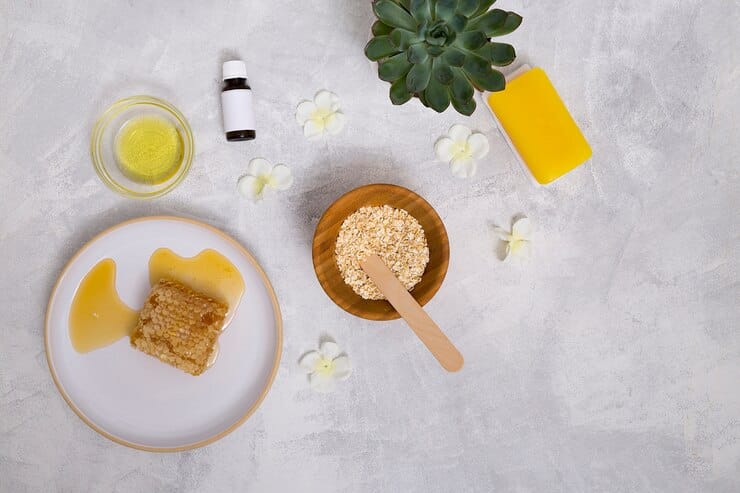
Ghee a natural ingredient is shown with oats honey and essential oil for skincare and hair care
The uses of ghee extend beyond cooking. It has been a secret beauty ingredient in many traditional treatments due to its deep nourishing properties. From keeping the skin moisturised to promoting healthy hair, ghee holds numerous topical uses for skin and hair care. Its rich nutrient profile deeply hydrates and nourishes the skin and hair, serving as a natural alternative to chemical-laden beauty products.
1. Natural moisturiser
Ghee has been used as a natural moisturiser for centuries in traditional Indian households. It is profoundly nourishing, providing hydration and suppleness to the skin. Ghee is packed with essential fatty acids that induce hydration in the skin cells, thereby moisturising dry skin areas. It is also loaded with skin-friendly vitamins and antioxidants that help combat skin dryness and dullness and promote skin health.
A layer of ghee on your skin can lock in moisture, ensuring your skin stays soft and glowing throughout the day. Ghee can easily penetrate deep into the layers of the skin, providing nourishment from within. The high antioxidant properties in ghee fight against skin damage and aid in anti-ageing. Regular use of ghee as a natural moisturiser can lead to soft, glowing and healthy skin.
2. Hair conditioning
Similarly, ghee is exceptionally beneficial for hair care. It can be used as a natural conditioner, owing to its deep hydrating properties. Hair exposed to harsh environmental conditions can become brittle and damaged. An application of ghee can help restore moisture and heal dry, damaged hair.
Regular massaging of ghee into the scalp nourishes the scalp deeply, ensuring overall scalp health. The fatty acids and other nutrients present in ghee work to strengthen hair roots, stimulate hair growth, and reduce split ends. Additionally, ghee helps soothe dry, itchy scalp by maintaining the pH balance of the scalp. The result is healthier, smoother, and shinier hair with regular application of ghee.
How is ghee used in Ayurveda and traditional medicine?
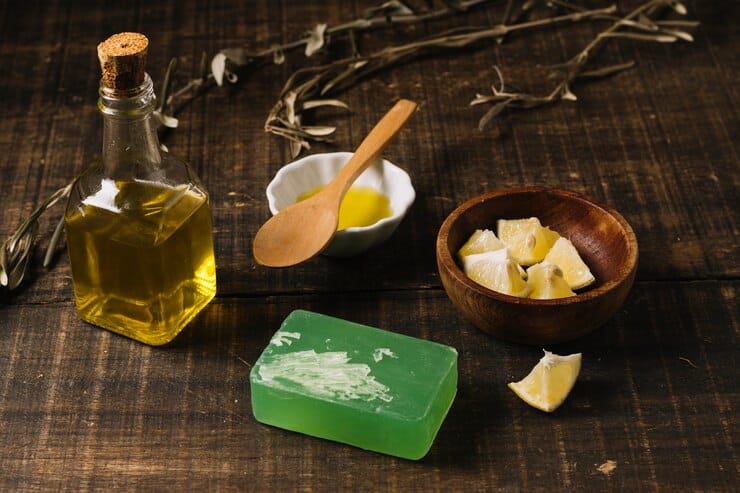
Ayurvedic medicine ingredients olive oil ghee lemon soap
The benefits of ghee go beyond the kitchen. Ghee has been extensively used in Ayurveda, the traditional Indian medicinal system, for centuries. Its potent healing properties have made ghee a valuable ingredient used to treat a wide range of ailments. From improving digestion to enhancing the immune system and boosting joint health, ghee is much more than just a dietary ingredient.
1. Digestive aid
In Ayurvedic medicine, ghee is known to enhance the function of the digestive system. Being rich in butyric acid, a type of short-chain fatty acid, ghee aids in lowering inflammation and helping in the repair of the stomach lining. It supports the natural functioning of the gut, improving gut health.
Ghee stimulates the secretion of stomach acids that aid in digestion. With its high concentration of butyrate, an essential nutrient for the intestine, ghee promotes healthy digestion and assists in the absorption and assimilation of nutrients. Regular consumption of ghee can help maintain a healthy digestive tract, lessen digestive problems, and promote overall well-being.
2. Enhancing immune system
- Rich in antioxidants: Ghee’s high amount of antioxidants helps fight harmful free radicals, enhancing the body’s ability to absorb essential nutrients, which is critical for maintaining a healthy immune system.
- Contains Butyric Acid: This short-chain fatty acid, present in ghee, has been associated with an immune response that can decrease inflammation and help improve the digestive system, subsequently enhancing immunity.
- Aids in the production of T-cells: ghee aids in the production of T-cells in the gut, which are the warriors in our body’s fight against infections, thus strengthening the immune system.
- Packed with essential vitamins: Ghee is loaded with Vitamins A, D, E, and K, which boost immunity and promote overall well-being.
- Good source of dietary fats: Dietary fats, like those found in ghee, are essential for the body to absorb certain vitamins and minerals from the food we eat, thus aiding in overall health and immunity.
- Ingredient: ghee is rich in antioxidants, contains butyric acid, aids in T-cell production, is packed with essential vitamins A, D, E, and K, and provides beneficial dietary fats.
3. Joint health and ghee
Ghee is traditionally known to lubricate the joints and enhance flexibility. Rich in fat-soluble vitamins like Vitamin K, it aids in calcium absorption, thereby leading to strong bones and healthy joints. In Ayurvedic medicine, ghee is often used to ease stiff joints.
Ghee’s anti-inflammatory properties can reduce inflammation in the joints and tissues, relieving pain and discomfort. Regular consumption or external application of ghee can also benefit the overall health of bones and joints. Maintaining bone and joint health contributes to increased mobility and movement and reduces the risks of conditions like arthritis or osteoporosis.
How can ghee support eye care?
Beyond the commonly known uses of ghee, it has some surprising applications that are beneficial for our health. Whether it’s maintaining eye health or providing relief from aches and congestion, ghee even finds purpose as a versatile home remedy, demonstrating its extensive range of benefits.
1. Eye drops and lubrication
Did you know that ghee could be an effective natural solution for dry eyes? Ghee’s fatty acid content helps hydrate and soothe dry eyes when used as an eye drop. A drop of room-temperature, pure cow ghee in each eye can keep them moist and bright.
Traditionally, the elderly in Indian households employed such a practice to maintain good eye health. Alongside keeping the eyes lubricated, ghee is also rich in Vitamin A, which is crucial for maintaining good vision. The use of ghee for eye care doesn’t stop at moisturising; it has also been used traditionally to improve blurry vision and promote overall eye health.
2. Earache and nasal congestion relief
A few drops of warm ghee can provide effective relief for minor earaches and nasal congestion. The warmth of the ghee helps soothe the inflammation causing the earache, thereby reducing pain and discomfort. Similarly, for nasal congestion, applying a few drops of warm ghee can help clear the nasal passages, aiding in easier breathing.
In Ayurveda, ghee’s nasal application is called “Nasya Karma.” A routine practice of Nasya Karma can help keep the nasal passages clear, improve the quality of voice, strengthen vision and promote overall nasal health. Despite the surprising application, it is always advised to consult with a healthcare provider before using ghee in such a way, especially if the condition persists.
What’s the best way to make ghee at home?
Contrary to popular belief, ghee is relatively straightforward and simple to make at home. Here’s an easy step-by-step guide:
- Start with unsalted butter. Take about 500 grams and cut it into cubes.
- In a saucepan, melt the butter on low heat.
- Once melted, the butter will begin to bubble and froth. This process is the water content of the butter evaporating.
- You’ll notice that white clumps (milk solids) begin to form in the mixture. Stir occasionally and keep a close eye on it to avoid burning.
- Turn off the heat as the milk solids settle at the bottom and turn golden brown and the liquid turns a clear golden colour.
- Allow the mixture to cool slightly before straining through a cheesecloth-lined sieve. The straining process separates the clear golden liquid fat (ghee) from the milk solids.
- Store the ghee in a clean jar. Your homemade ghee can remain fresh for months without refrigeration.
Conclusion
Ghee is a superfood that encompasses culinary versatility and many health benefits. Whether it’s popping up on your dinner table or being used as a skin moisturiser, ghee has proved its worth for thousands of years across cultures. With a sublime blend of nutrients and a trail of health benefits that contribute to heart health, weight management, gut health, skin and hair care, and more, ghee surely commands the reputation it holds.
Although ghee has a high-fat content, it’s important to remember that not all fats are bad – moderation is the key. As we have discovered, every dollop of ghee enriches our food with exquisite taste and health benefits, making it a worthy addition to a conscious and balanced diet.
Frequently asked questions
1. Is ghee better than butter for cooking?
Yes, owing to its high smoke point, ghee can withstand higher cooking temperatures without losing its nutritional value or developing harmful free radicals, making it better than butter for cooking, especially high-heat cooking.
2. Why are ghee prices higher than regular butter?
Ghee prices are usually higher than regular butter due to the production process, quality of ingredients, and demand for ghee. The traditional method of making ghee is labour-intensive, using high-quality butter, resulting in a premium product sought after by many.
3. How can I store ghee for a long period of time?
Ghee can be stored in an airtight container and kept in a cool, dry place away from direct sunlight. It remains fresh for months without the need for refrigeration.
4. Are there any side effects of using ghee?
While ghee has numerous benefits, overindulgence can lead to an increase in body weight and higher cholesterol levels. Therefore, though it packs a nutritional punch, moderation in consumption is recommended.

